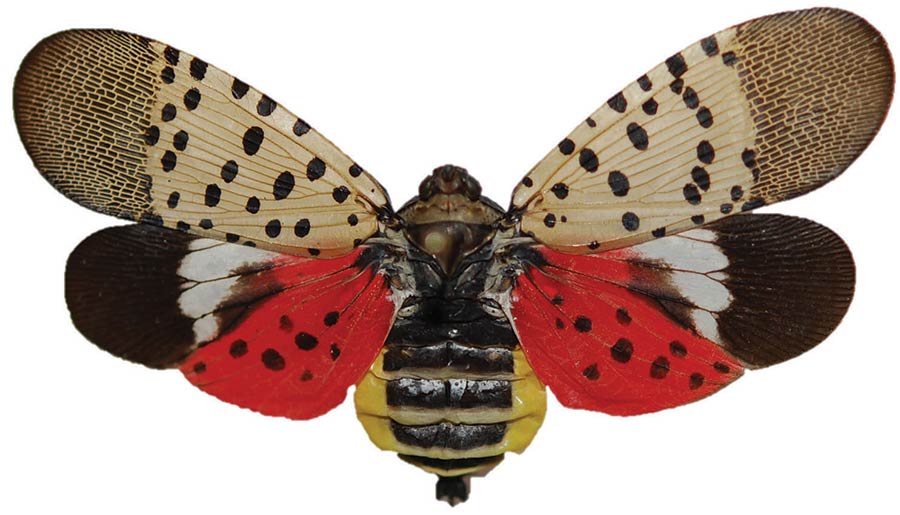 Photo credit: USDA
Photo credit: USDA
As farmers confronted the many challenges presented by climate change, 2018 brought yet another unpleasant surprise: the spotted lanternfly (SLF). Anyone who has not yet heard about this pest will soon learn a lot about its habits, and its potential for creating expensive mayhem. In Pennsylvania, agriculture is a diverse and powerful driver of the economy. The state is the nation’s leading producer of hardwood, a multi-billion-dollar industry. Turns out, hardwood trees are part of the SLF diet plan. Additionally, the state has growing wine and craft beer industries, both of which are vulnerable to a burgeoning pest like SLF. And Pennsylvania is currently ground zero for SLF infestations.
The Pennsylvania Department of Agriculture has declared a multi-county quarantine zone, where established SLF populations have been identified. The counties of Berks, Bucks, Carbon, Chester, Delaware, Lancaster, Lebanon, Lehigh, Monroe, Montgomery, Northampton, Philadelphia and Schuylkill are included in the quarantine zone. And then there is this. Beginning May 1, certain businesses and organizations will be required to have SLF permits “if they move vehicles, products or other conveyances within or out of the quarantine zone.” That would include businesses that move hay, grain, manure—even possibly livestock.
The spotted lanternfly (SLF) was first discovered in Pennsylvania in 2014. Since then, the pest has spread to neighboring states, including New Jersey and Delaware. As of mid-January, there were no established populations detected in Maryland, although the Department of Agriculture there is watching carefully.
Native to China, Viet Nam and Korea, this bug is a voracious feeder on everything from grapevines to nut trees. They feed on tree sap and excrete a sticky substance called “honeydew,” which attracts other insects, such as wasps, bees and flies. Honeydew promotes the growth of a sooty black mold that can cover leaves and fruits such as grapes. While scientists worry about exactly how destructive these pests can become, the potential for catastrophic losses is high.
Who Ya Gonna Call?
SLF is such a threat to agriculture that there is actually a hotline manned by Penn State University, where callers can report sightings of the pest, and find out how to identify its eggs and larvae. The number is 1-888-4BAD-FLY, and callers can find out more about the permit process. The SLF permit requires individuals to complete an online course. The program is set up as a “train the trainer” process, in which an individual is designated as an organization’s trainer. That individual will then be expected to train others in his or her organization.
Pennsylvania’s Department of Agriculture and Penn State University teamed up to create the training program which will help designated employees understand how to operate within the quarantine zone.
The two-hour course, according to the Penn State Extension website, includes training on:
- Understanding the importance of stopping spotted lanternfly
- Learning the lifecycle and habits of spotted lanternfly
- Understanding why there is a quarantine zone and how it works
- Finding and destroying spotted lanternfly
- Implementing best practices to follow while working in the quarantine zone.
What’s Next?
According to the Penn State website, after an individual has successfully completes the course, his or her company will receive SLF permits for company vehicles. Beyond that, though, science continues working on solutions. Pennsylvania, like its neighbors, relies on pollinators for crops such as flowers, soybeans, vegetables, etc. Insecticides could kill SLF along with important pollinators such as butterflies and bees. Longer-term solutions include predators that attack SLF. But these won’t be widely available quickly.
According to scientists, SLF are unusual, in that they lay their eggs anywhere there’s a flat surface—whether that surface is on a host tree or a nearby rock. The eggs look like a mud splat. Farmers may not have the time and personnel to check trees throughout their properties for things that look like mud splatters. But homeowners can survey their properties—looking for evidence of SLF eggs, which won’t hatch until warmer weather in the Spring. The Penn State Extension website offers extensive photos about how to control the insect, identify the eggs and destroy the eggs.
People—hikers, home gardeners, farmers, nursery workers—everyone has a role to play in controlling and eliminating this invasive pest. The good news is that there are ample resources anyone can access to join the battle.




